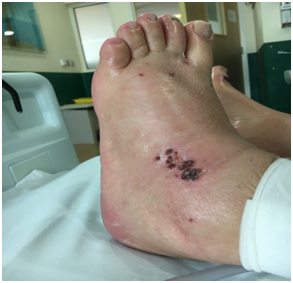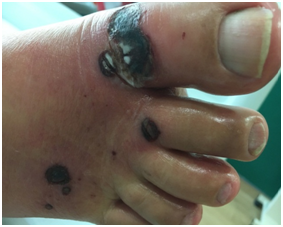Journal of
eISSN: 2373-4396


Case Report Volume 7 Issue 2
HAMAD Medical Corporation, The Cuban Hospital, Qatar
Correspondence: Guillermo Alberto Perez Fernandez, HAMAD Medical Corporation, The Cuban Hospital, Dukhan, Qatar,, Tel 974-70218518
Received: October 29, 2016 | Published: November 25, 2016
Citation: Fernandez GAP, Farinas GN, Sandoval CAP (2016) Late-Onset Warfarin-Induced Skin Necrosis: A Standing Shadow. J Cardiol Curr Res 7(2): 00246. DOI: 10.15406/jccr.2016.07.00246
One of the clinical situations linked to the use of warfarin is the skin necrosis occurring in approximately 0.01 to 0.1% of all patients receiving warfarin. Typically, lesions develop during the first days after initiation of warfarin therapy (usually around the tenth day) and are often associated with the administration of a loading dose. The pathophysiological mechanisms for warfarin-induced skin necrosis, despite several theories, remain uncertain. For the diagnosis, along with a high degree of suspicion, a rapid recognition and management is required.
Warfarin-induced skin necrosis (WISN) is a complication of therapy with coumarin associated with a high morbidity and mortality [1]. In 1943, the necrotic changes were first time described on the skin of a patient taking warfarin, at that time it was called "disseminated thrombophlebitis migrans" [2] and were not related to the use of warfarin. Later in 1954, Verhagen reported 13 confirmed cases of warfarin-induced skin necrosis [3].
Overall, these lesions occur in approximately 0.01 to 0.1% of all patients receiving warfarin with a predilection for females in up to 90% of cases, being the typical patient a middle-aged, obese, female with history of deep vein thrombosis or pulmonary thromboembolism, with in most cases a reported protein C, S, Factor V Leiden, and antithrombin III deficiency [4].
82 year old female palestinian patient with a medical background of diabetes mellitus type II, essential hypertension and ischemic dilated cardiomyopathy (New York Heart Association Classification grade II), severe coronary three vessels disease undergoing stenting in coronary descending artery nine years ago and being a pacemaker holder due to a sick sinus node six months ago. In addition she was diagnosed a chronic atrial fibrillation two years ago being on warfarin since then, apart from other drugs to control her multiple comorbidities.
After a period of clinical stability for the last three months, the patient was admitted in our hospital with a diagnosis of acute pulmonary edema being treated in Intensive Care Unit (ICU) with standard therapy. Moreover, upon first physical examination in ICU were noticed some blisters with red borders filled with what appeared to be a dark bloody contents on the skin of the dorsum of the right foot and left foot in number of three in each food with a variable diameter, being the largest of 3 cm of diameter on the right foot and tenderness upon palpation. After two days, there was a perceptible improvement in the cardiac status of the patient and was transferred to medical ward with still mild to moderate edemas in both feet. The international normalized ratio (INR) was 1.8. The chest X ray showed mild pulmonary congestion. The electrocardiogram revealed an atrial fibrillation with normal ventricular response and by transthoracic echocardiogram the ejection fraction was 35-40 %.
On day fourth of hospitalization, the lesions on both feet looked like the ones shown in Figure 1 and 2 being requested a consultation with a dermatologist and a vascular surgeon whom after their assessment stated that the patient was having a WISN. Immediately, warfarin was discontinued and the patient was started of enoxaparin. The lesion began to being treated topically with clobetazol in cream. At that time was requested a blood protein C and S activity that came up normal days after.


After 10 days of thorough observation of the progression of the lesions, there was an improvement of them indicating signs of going into remission and with not need of further debridement. Due to the improvement of the largest lesions after the warfarin’s withdrawal and the disappearance of those in formation was agreed not to perform a cutaneous biopsy. Subsequently, upon discharge, enoxaparin was shifted to dabigatran for home treatment.
The WISN as a complication of warfarin usage is uncommon. Typically, lesions develop during the first days after initiation of warfarin therapy (usually around the tenth day) and are often associated with the administration of a loading dose. The pathophysiological mechanisms for warfarin-induced skin necrosis, despite several theories, remain uncertain, although, it has been informed to be related with microvascular thrombosis, hypersensitivity to warfarin and a direct toxic effect of the drug. However, the most likely mechanism seems to be a temporary imbalance between the anticoagulant-procoagulant system, more specifically associated with a rapid decrease in C and S protein levels during initial therapy with warfarin [5]. Regarding the lesions associated with this condition, the patient first presents an erythematous rash poorly demarcated and often associated with tissue soft edema and paresthesias, subsequently might appear petechiae progressing within hours to ecchymoses and large hemorrhagic blisters that turn into a frank necrosis. In most cases is a single lesion, although, up to one third of cases can develop multiple lesions. These lesions can develop at any part of the body, but have a predilection for high fat areas like breasts, buttocks, thighs, arms, hands, fingers, legs, feet, face and abdomen. In men, the lesions can affect the skin of the penis [6].
For the diagnosis, along with a high degree of suspicion, a rapid recognition and management is required. Once the lesions are recognized, stop warfarin must be the first step in the treatment, and replace it by unfractionated or low molecular weight heparin to prevent further thrombi formation. The use of vitamin K and frozen fresh plasma for a quick replacement of protein levels C and S is also suggested in these cases, in addition, the treatment with protein C concentrates is postulated to stop the progression of lesions and promotes healing. It is also said that over 50% of patients might require extensive debridement and surgical management [7].
The late onset of WISN is very uncommon, few case have been reported in the literature. However, there are reports of late lesions onset up to three years after the initiation of warfarin therapy. It is suspected that late-onset Warfarin-induced necrosis is a result of poor compliance with Warfarin dosage schedules, with the patient stopping and subsequently restarting the medication without heparin coverage [8]. In our patient the suspension of warfarin and its replacement with dabigatran, stopped the progression of the lesions which were treated also with a local steroid cream being noticeable the healing process over time which took over one month. I would like to stress that this case might represent another stepping stone to help break the “old habit” of starting patients on warfarin for long term anticoagulation-required disease and ponder the possibility of drugs as dabigatran which has proved to be less harmful in terms of side effects or use-related complications, besides a faster onset and offset action, absence of an effect of dietary vitamin K intake on their activity, and fewer drug interactions [4].
It is not about belittling the old and long live-saving warfarin, it is about to know who will benefit or harm most when it comes to begin anticoagulation treatment with warfarin. It is not infrequent the initiation of treatment with warfarin in patients who can afford new drugs as dabigatran, but the first choice in our mind most time is warfarin and no doubts, in some patient on the long run, warfarin will not do well and the skin necrosis is like a shadow that always stands and might appear at any time.

©2016 Fernandez, et al. This is an open access article distributed under the terms of the, which permits unrestricted use, distribution, and build upon your work non-commercially.